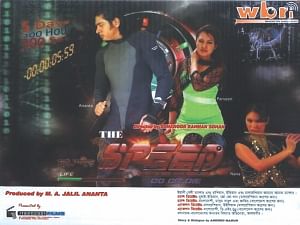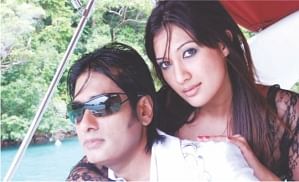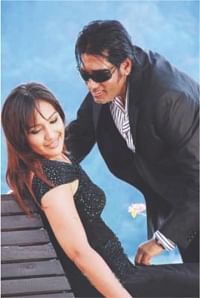| Home - Back Issues - The Team - Contact Us |
 |
| Volume 11 |Issue 21| May 25, 2012 | |
|
|
Perspective In Search of the Speed Sushmita S Preetha Sometimes we like a piece of art because it's brilliant, nuanced and interesting; we may like the screenplay of a movie for its depth of characters, a production because of its attention to details, or an actor because of his sublime performance. Once in a while, however, we come across a piece that is so incredibly bad that it challenges the good-bad continuum, turning all aesthetic considerations on its head. Instead of finding a bad song or show nauseating, we begin to like it, seduced by its utter lack of originality, creativity or talent. Case in point: the warped appeal of Rebecca Black's “Friday, Friday, Friday” or the everyday melodramas of the “Real Housewives of New Jersey”. They're so bad that they go full circle and become awesome.
The “so-bad-it's-good” is not an altogether novel concept in pop culture, but it has gained new and exciting significance in Bangladesh with the debut of M A Jalil Anonto, the inimitable actor/director of the iconic film, Khoj (the Search). Released in 2010, it was an immediate blockbuster hit, dazzling millions of Bangladeshis both here and abroad with its sizzling absurdity. Beginning with its unforgettable dialogues, “Eeu deshtoy my counnty, I deshtoy eeu,” and “Tui ki bolte chacchish 50/50, Anonto robot hoye ferot asche? (What do you want to say 50/50, Anonto has returned as a robot?)” to the luminosity of each character – how can one ever get over Major Mahmood or Captain Bobby – the movie was an all-out riot, and Anonto, an immediate sensation. He managed to create his own loyal fandom – fans, who, mindd it, appreciated him for his atrocious acting “skills”, mispronunciations of both English and Bengali dialogues and curvy physique. After the success of Khoj (the search)and Hridoy Bhanga Dheu (Heartbreaking Blow) released last year, Anonto is back with his new film, The Speed: Do or Die. Yet again, the fearless actor and his gang has become the latest fad in the city, with discussions of The Speed, reigning supreme in schools, offices, cafes and the cyber world, accompanied by random but passionate outbursts of “Kisshteeeenaa” or “Isstopp”. The film revolves around the life of Ononno Chowdhury, an honest and patriotic industrialist, who lives with his precocious niece, Brishty, and her two baby-sitters. The baby-sitters are every Bangladeshi man's dream gone wrong – obese middle-aged women in identical mini-skirts, white shirts, knee-length socks and two pigtails, whose sole roles in the film are to stand around in the living room with pouting faces.
Kibria shaheb, played by Alamgir, is a corrupt industrialist who is threatened by Ononno's noble ways. He first sends in a local goon, who fails miserably when poised against the invincible hero. One cannot help but be impressed by Ononno's dexterity at thrashing the villain who, in an earlier scene, had proved his might by spinning a powerful politician over his head a few times. Our hero kicks the goon with such power that the latter flies through the air, breaks the ceiling of a building and falls right at Kibria's feet. That's when Ononno exclaims, “Honest people don't challenge corrupt ones, they threat!” Kibria then contacts Nino, a foreign supplier of defective goods, to take care of Ononno once and for all. Meanwhile, Ononno's GM's sister, the lovely Shondha, comes back from London, and almost immediately falls in love with him after seeing his posters in his office. Her love is further solidified when she films him saving his workers from a fire on her Iphone 4. Ononno is no fool either, and he doesn't fail to notice the charms of the London-returned fashion-designer. But it is only when his niece approves of Shondha that he sends her a marriage proposal – after precisely two days of knowing each other. For his honeymoon, the patriotic Ononno chooses to visit our very own Cox's Bazaar, accompanied by his wife and niece. But alas! Their threesome is soon wrecked, when Nino's men turn up on the sea beach and kill his niece. Heartbroken, the two of them leave for Malaysia, where Nino's men attack again, but this time, they kidnap Shondha and injure Ononno. In the hospital, he receives a digital watch along with a message that says he has five days to obtain the retina scan of five of Kibria's peeps and save Shondha. The rest of the movie is a whirlwind of fight sequences – well, not a whirlwind, per se, more like a slow breeze – disrupted only by songs of longing and pain, a platonic affair between Ononno and Christina, a totally unnecessary item song and Christina's ultimate death. Needless to say, Ononno manages to obtain the retina scan of all the goons except that of Kibria, who shoots himself in the head to ensure that Shondha dies in the chamber from lack of oxygen. Ononno tries in vain to open the dead Kibria's eyes. What follows is perhaps the ultimate act of fantastical farce. (If you haven't watched the film yet, I advise you don't read the next sentence.) Having failed to open the chamber using every possible means, he prays to Allah and holds up his tabij to the glass. Lo and behold! The unbreakable glass shatters in seconds, leaving our hero and heroine to live happily ever after.
The storyline itself is rather dull for my liking, lacking the “speed” of Ononto's previous movies. It does, however, have its fair share of memorable quips, disturbing images, unprofessional editing, and really, really bad acting, which, all in all, make the movie a must-watch. Ononto is a pleasure to experience as always. His rendition of every dialogue is made more unforgettable by his accent and his inability to pronounce “r”s: “Kisshteena”, “eye contaak”, “you don know my deeteils but I know eeurs,” “potishtaan (protishthan)” or “kuno” (kono/any). His physique is equally striking – one cannot help but notice his heaving bosom during every chase scene, and wish he had a scarf over his body-hugging t-shirts. (I kid you not, when he got shot, I overheard a woman in the next seat exclaim, “Oh, no, he just lost one of his breasts!”) As eye-catching as Ononto's physique was the blatant glorification of the present government in the movie. When Shondha comes back to Dhaka, she comments how much Dhaka has changed and how it seems impossible that this country has people who live below the poverty line. To that, his brother proudly replies: “Since the present government came to power, it has done a lot to improve the condition of this country.” There are other references smeared all throughout the movie – from mentions of digital Bangladesh to war criminals to our country's growth and progress. M A Jalil Anonto, after all, doesn't believe in making movies that don't have a social message! However, as I left the movie theatre, sprightly and satisfied, a few unresolved questions quivered in my mind. Why did an actor of such calibre as Alamgir agree to act in this film? More importantly, why did he, aka Mr Kibria, revolve an unlit cigarette in every scene, sniffing it as he threatened our hero, only lighting it once before his death? It would have been symbolic had Nino, the once Bangladeshi criminal who had undergone plastic surgery and a name change, boarded PIA to signify his evilness and our nationalistic heroine, the Biman. But why did the heroine and the villain both arrive on PIA? Why did Ononno fire Shondha from his office before sending her a marriage proposal? Does he not believe in women's right to work? Even if we overlook the overflow of love between Ononno and his niece, in the form of cajoling and canoodling, how do we make sense of the song-and-dance sequence, where she is seen in a white one-shoulder gown, in his convertible, standing in the wind, with her hair and scarf flying to the beat of the song? The lyrics are equally suggestive; at one point, Brishty actually sings something to the effect, “When I grow up, we will be able to build our dreams together”. Equally questionable is his suggestion to Shondha on his wedding night that Brishty stay with them in their room. How did he know which five people's retina scan to take? Why did all the goons wear hoodies in bright blue or red? Why did all the Malaysian officials and citizens look Bangladeshi? And last but not the least, how can the director, producer, crew and cast possibly take this film seriously. The whole movie is so poorly executed, the editing so sloppy, the dialogues and screenplay so silly and the acting so ghastly that a kind of magnificence creeps into it. As such, as far as “it's-so-bad-it's-good” films go, The Speed: Do or Die, quite rightly deserves a position among the best of the worst.
Copyright
(R) thedailystar.net 2012 |


